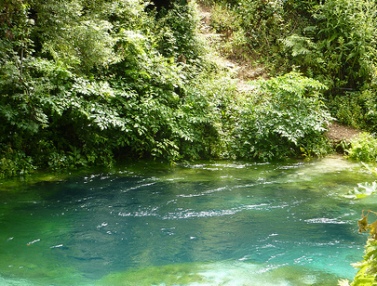

Location: Saranda
The Blue Eye Spring (Syri i Kaltër in Albanian, which translates as "Blue Eye") is one of the most impressive natural attractions in Albania, located in the south of the country. It is a karst spring, which is a deep pool of crystal clear water, shimmering in shades of blue and light blue, reminiscent of the human eye: the dark blue center symbolizes the pupil, and the bright blue edges are the iris. The spring is located in the village of Muzine, in the municipality of Finik, Vlore County, near the cities of Saranda (approximately 16-30 km to the northeast) and Gjirokastra. The exact coordinates are: 39°55′25″ N 20°11′34″ E. d. It is located at an altitude of about 152 meters above sea level, at the foot of the mountains, in a picturesque wooded area with oaks, plane trees, walnuts, cherries, pines and firs.
The spring is formed by several underground springs (according to various sources, from 18 sources), which beat out of a karst funnel. The water in the center has a rich dark blue color, and at the edges - bright blue, which creates a spectacular optical effect in the sun. The depth of the reservoir is not exactly known: divers were able to descend only 45-50 meters due to the strong water pressure, but it is assumed that it can exceed 100 meters. Water breaks out to the surface with the force of a fountain, with a flow rate of up to 18,400 liters per second (or about 6-10 cubic meters per second), which makes it look like a boiling cauldron. The water temperature is constant all year round - about + 10-13 ° C, it does not freeze even in winter. The water is crystal clear, with a mineral composition, and is suitable for drinking, although very cold. This spring is the source of the Bistricë River, which flows for 25 km and empties into the Ionian Sea south of Saranda. The river feeds the local hydroelectric power station, highlighting the practical importance of the spring.
The Blue Eye is a typical karst phenomenon, formed by the dissolution of limestone rocks by groundwater. The surrounding area is a national park of about 180 hectares, with a protected area of 1.8 km². Oaks, plane trees and other trees grow here, creating a dense forest cover. In 1996, the spring was declared a natural monument and is managed by the Albanian Ministry of Environment. The ecological importance lies in the preservation of biodiversity: the area is rich in flora and fauna, including rare species of birds and insects. However, there have been incidents, such as the temporary drying up of the spring in the summer of 2004 due to drought and a fire in 2017 that damaged part of the forest.
Historically, the spring has been known for a long time, but as a
tourist attraction it has become popular in recent decades. During the
communist regime in Albania (until the 1990s), access was limited, but
now it is an open place.
There are several legends associated with
the spring. One of the most popular tells of a giant snake (or dragon)
that emerged from the sea during a storm and terrorized the Illyrians,
the ancient inhabitants of the region. The snake devoured people,
animals and crops. A brave old man decided to destroy it: he loaded a
donkey with bags of tinder (a highly flammable material), set it on fire
and hid. The snake swallowed the donkey, but the fire inside it began to
burn. In agony, it thrashed about, begging the sea and the mountains for
help, and then rushed into the mountains. There, one of its eyes fell
out and turned into a spring, from which the snake's "tears" - pure
water - still flow. This legend emphasizes the mythical nature of the
place and connects it with the ancient history of Albania, known as the
"Land of Eagles".
Getting to the Blue Eye is relatively easy. From Saranda or
Gjirokastra, you can drive along the Saranda-Gjirokastra road through
the village of Muzine (Krongj). The distance from Saranda is about 20-30
km, travel time is 30-45 minutes. There is public transport: buses
between Saranda and Gjirokastra stop near the entrance to the park (the
fare is about 150-200 lek, or 1-2 dollars). You can ask the driver to
drop you off at the park. Cycling routes are also popular - one of the
most beautiful in Albania, with bike rental in Saranda (up to 1000 lek
per day). From the parking lot to the spring itself there is a walking
trail of about 3 km through the forest, with signs, bridges and views of
a small Orthodox church, a lake and a dam. Entrance to the park is free
in winter, in summer there is a small fee - about 200 lek ($ 2) per
person or 100 lek per car. The place is open 24 hours a day, but it is
better to visit during the day for better lighting.
There is a small
infrastructure on the territory: a restaurant with traditional Albanian
cuisine (roasted lamb, grilled fish, vegetables, rakija), a cafe and
souvenir shops. Tourists can swim in the water, but because of the cold,
few do it - cramps often occur. It is recommended to take a towel and
warm clothes. There is lush greenery around, which makes the place ideal
for photos and picnics. Every year, thousands of tourists visit the
spring, especially in summer. Nearby, you can visit the ancient city of
Butrint (UNESCO, 15 km south of Saranda) or the castle of Lekursi. The
Blue Eye is not only a natural wonder, but also a symbol of Albania's
purity and mystery, attracting ecotourism and adventure lovers. A visit
leaves an unforgettable impression of the combination of beauty,
freshness and myths.